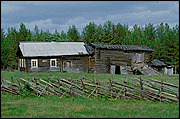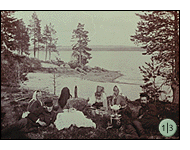|
 Pirttilahti
is one of the villages visited in 1825 by A.J. Sjögren, the
first poetry collector to come to Viena. His work was not available
to Lönnrot until the latter was working on the second edition
of the Kalevala. Lönnrot himself visited Pirttilahti in 1833
on his fourth field trip on his way from Vuonninen to Vuokkiniemi
by boat, but he did not succeed in recording any poems. Pirttilahti
is one of the villages visited in 1825 by A.J. Sjögren, the
first poetry collector to come to Viena. His work was not available
to Lönnrot until the latter was working on the second edition
of the Kalevala. Lönnrot himself visited Pirttilahti in 1833
on his fourth field trip on his way from Vuonninen to Vuokkiniemi
by boat, but he did not succeed in recording any poems.
Rowing Lönnrot on this part of the journey were the wife,
daughter-in-law, and daughter of Ontrei Malinen, the great bard
of Vuonninen. Originally, they were only to row Lönnrot as
far as Mölkkö, but asked if they could take him to Vuokkiniemi
in order to earn more money for their service. Lönnrot agreed,
but they soon met a boat at Pirttilahti that was going to the mill
at Köynäskoski via Vuokkiniemi, and Lönnrot asked
if he could continue his journey on that craft:
But as it was evening and we had 5 km left to Vuokkiniemi,
we decided to spend the night in a house in Pirttilahti. The mistress
of the house had the habit of swearing after every three words she
said, but otherwise she was very good-natured; it was just that
swearing had become a habit.
I had been told that the master of the house was an excellent singer
but he completely refused to sing anything for me.
Early the following morning, Lönnrot continued his journey
and had no time to try to collect poetry in the other households
in the village.
Unfortunately, I.K. Inha, who photographed Viena in 1894, took
no pictures of Pirttilahti. However, he did stop to photograph Ristiniemi
Point on his way home. Among the photographs he took there was the
only one from his entire trip that includes him. Inha also photographed
a cross erected  near the water's edge on the point so that later generations would
know what this significant monument was. He describes the place
as follows:
near the water's edge on the point so that later generations would
know what this significant monument was. He describes the place
as follows:
The point extends its pure sandy shores out into the middle
of the lake and is covered with murmuring pines. People often stop
there on their way to Vuokkiniemi to wait for fair weather if the
wind is strong out on the open water. On the point, there is a cross
under a little shelter in the shade of some rough-barked pines and
people pray there for a safe trip, making the sign of the Cross
and bowing. At the same time, they remember their old, pagan spirits
by gathering rocks at the base of the cross or by hanging a strip
of cloth on the cross to blow in the wind. Behind the enclosure
there is, as one can imagine, quite a pile of wave-smoothed rocks
taken from the lake shore.
 Ristiniemi
is thus Viena's "Cape of Good Hope." For travellers, reaching
Ristiniemi meant that the rest of the journey to Vuokkiniemi would
be safe, for the perils of the rough, open waters were behind them.
Those coming from Vuokkiniemi, on the other hand, could tell when
they got to Ristiniemi whether there was any sense in venturing
further onto the open expanse of the lake. Ristiniemi
is thus Viena's "Cape of Good Hope." For travellers, reaching
Ristiniemi meant that the rest of the journey to Vuokkiniemi would
be safe, for the perils of the rough, open waters were behind them.
Those coming from Vuokkiniemi, on the other hand, could tell when
they got to Ristiniemi whether there was any sense in venturing
further onto the open expanse of the lake.
Pirttilahti
What to see
Panorama
Audio sample
|
